china thing sucks
I GOTS TO GO
Age 38, Male
military
UCLA
USA or MEXICO
Joined on 2/16/08
- Level:
- 7
- Exp Points:
- 460 / 550
- Exp Rank:
- > 100,000
- Vote Power:
- 4.90 votes
- Rank:
- Civilian
- Global Rank:
- > 100,000
- Blams:
- 44
- Saves:
- 6
- B/P Bonus:
- 0%
- Whistle:
- Normal
- Medals:
- 291
Posted by XxTATERTHOOTHXx - April 1st, 2009
what the hell I cant see my medals or play my favorite flash
Posted by XxTATERTHOOTHXx - March 22nd, 2009
Me and xxdeath123xx are going to make an adventure and multiplayer game. A beta of the game should
come soon our progress is pretty slow so it should come around febuary 2010 or maybe sooner
if progress speeds up so right now were working on the enviorment and buildings now we'll
keep everyone posted.We just finished drawing it.Check my page for updates or his page at
http://xxdeath123xx.newgrounds.com/
XxTATERTHOOTHXx
Posted by XxTATERTHOOTHXx - March 17th, 2009
Well I havent posted in a while I needed to get back some room on my page so if you want to learn
a little some thing about RPG 7 go to my news thing and go to the second to the last post.
Posted by XxTATERTHOOTHXx - March 14th, 2009
The RPG-7
The RPG-7 anti-tank grenade launcher is robust, simple and lethal. It is also extremely popular. As it exists today, the RPG-7 is the result of many years of revisions and modifications. The "original" RPG -- based on the German Panzerfaust anti-tank weapon - was eventually followed by the RPG-2, the RPG-3 and so on. In fact, although the RPG-4 had passed field trials in 1961, test findings of a newer model, the RPG-7, were released that same year, but with much improved firing range and armor piercing capabilities. So in 1961 it was the RPG-7, not the RPG-4, which the Soviet Armed forces adopted for actual use. Today, the RPG-7 is used by the armies of over forty different countries and is also used, reportedly, by a range of terrorist organizations in the Middle East and Latin Americas.
Now that we know what an RPG-7 is, let's take a look at how one operates.
Firing an RPG-7
The RPG operator or an artillary assistant takes a propelling charge (booster, in image below) and screws it onto the end of a warhead. Basically, this is a stabilizing pipe that has four stabilizing fins that are folded around it with two additional fins at its rear end. A cardboard container encases the back end of the stabilizing pipe. Inside the cardboard container, a squib of nitroglycerin powder is wrapped around the stabilizing pipe and a primer or charge of gunpowder is stuffed into the end of the stabilizing pipe.
The RPG operator or artillary person then takes this assembled artillery and loads it into the front end of the RPG launcher so that it lines up with the trigger mechanism.
After the RPG operator pulls the trigger, this is what happens:
A percussion cap ignites the primer, gases build up inside the launcher's chamber, thereby breaking apart the cardboard container and propelling the grenade forward through the barrel of the launcher. In this way, the cardboard container is a lot like the casing containing the gunpowder on a bullet.
The force of the built-up gases throws the grenade out of the tube at approximately 384 feet per second (117 meters per second). The abrupt acceleration of the grenade leaving the launcher triggers a piezoelectric fuze that ignites the primer (pyro-retarding gunpowder mixture). This then ignites the squib of nitro, thereby activating the rocket propulsion system (sustainer motor) to carry the grenade the rest of its trajectory.
As the grenade leaves the launcher, the fins along the stabilizing pipe spread out, which, along with the rocket motor, allow the grenade to travel a long distance at a potential speed of about 965 feet per second (294 meters per second). The grenade moves like a football, rotating through the air; the fins stabilize its flight.
A socket in the breach block alleviates recoil during firing. The exhaust gases exit to the rear of the launcher unit and the operator is free to immediately reload the weapon. In practice, however, no RPG operator would ever remain stationary and spend the time to reload; the launching flash and whitish blue-gray smoke provides a clear indication to the enemy of the RPG launcher's location. An effective, surviving RPG operator is one who quickly changes position and gets under cover.
There are several types of grenades that can be used in the RPG-7. Some have a point initiating, base-detonating (PIBD) piezoelectric fuze: meaning that they are impact grenades. And, many others have back-up time delay systems, so that if they have not reached a target in a certain amount of time (something like four and a half seconds) the grenade will self destruct. The most commonly launched grenades are a High Explosive(HE) or High Explosive Anti Tank (HEAT) rounds.
Impact grenades must be unarmed until they are actually fired because any accidental contact might set them off. Since they are usually shot from a launcher, they must have an automatic arming system. In some designs, like the one we describe above, the arming system is triggered by the propellant explosion that drives the grenade out of the launcher. In other designs, the grenade's acceleration or rotation during its flight arms the detonator.
As for the back-up timed delay, the same fuze mechanism that sets off the the rocket would set this off. The spark ignites a slow-burning material in the fuze. In about four seconds, the delay material burns all the way through. The end of the delay element is connected to the detonator. The burning material at the end of the delay ignites the material in the detonator, thereby exploding the warhead.
Tactics: How Are RPGs Used?
The basic principle behind the effective use of rocket-propelled grenades is to get as close as possible to the target and to ensure the shot is accurate. The tell-tale trail of smoke emanating from the RPG means that the RPG operator and his assistant can quickly become visible.
Buildings, vehicles with little or no armor and, of course, human beings are all vulnerable to RPG fire. In particular, the fragments from exploding grenades can cause considerable damage to troops, and this principle was used effectively against Mujahideen firing positions dug into mountain slopes. A rocket-propelled grenade would be fired above and behind the firing position, raining down shrapnel and rock onto the hidden troops.
Photo courtesy Department of Defense Defense Visual Information Center
Capt. Jose R. Atencia, 77th Explosive Ordnance Disposal Unit, handles abandoned Iraqi RPG-7 High Explosive Anti-Tank (HEAT) rockets in the aftermath of Operation Desert Storm.
Of course, rocket-propelled grenades are most efficient when deployed in small groups. Two or three shots at a vehicle from close range increases the chances of destroying the vehicle, and can even be effective in destroying an armored tank. A first shot takes out the driver's viewing prism, and further shots work their way through the armor, concentrating on one particular spot.
Helicopters, too, are easily ambushed when landing or hovering; rocket-propelled grenades downed both US Black hawk helicopters lost in Mogadishu and Somalia.
Photo courtesy Department of Defense Defense Visual Information Center
Staff Sgt. James Bradsher demonstrates the use of a Soviet-made RPG-7 portable rocket launcher during exercise Volant Scorpion.
Given the effectiveness of well-used RPGs, what strategies are there for defense? When it comes to avoiding vehicle losses from rocket-propelled grenades, a tactic adopted by less well-equipped armies is to send in infantry screens. Armies with more resources may use bombs or napalm to sweep areas in which RPGs may be located.
Another obvious tactic adopted by the Russians when fighting against the Mujahideen between 1979 and 1989 was to remain at least 1,000 feet (300 meters) away from the enemy, out of RPG-7 and AK-47 Kalashinikov assault rifle range.
RPGs: The Future
Photo courtesy Department of Defense Defense Visual Information Center
A grenade is inserted into the muzzle of a Soviet RPG-7 portable rocket launcher.
Although over forty years have passed since the 1961 introduction of the RPG, the rocket-propelled grenade remains one of the most common and effective infantry weapons currently in use. Rugged and simple, suitable for downing helicopters, disabling tanks or attacking buildings at close range, in the hands of a skilled operator, the RPG is a lethal and versatile weapon that will remain popular for some time.
Despite this, there is always room for modification. Lighter weapons with greater range and destructive capability are always being developed, and there may even be the possibility of automatic or semi-automatic rocket-propelled grenade systems.
The accuracy of rocket-propelled grenades is another area where improvements can be made. Laser guidance systems, though expensive, would greatly increase accuracy. An encoded laser could be trained on the target -- providing reference information to the rocket, thereby allowing it to make appropriate in-flight corrections to its trajectory. Other systems, perhaps utilizing GPS satellite technology could also become incorporated in future versions of RPG weaponry



